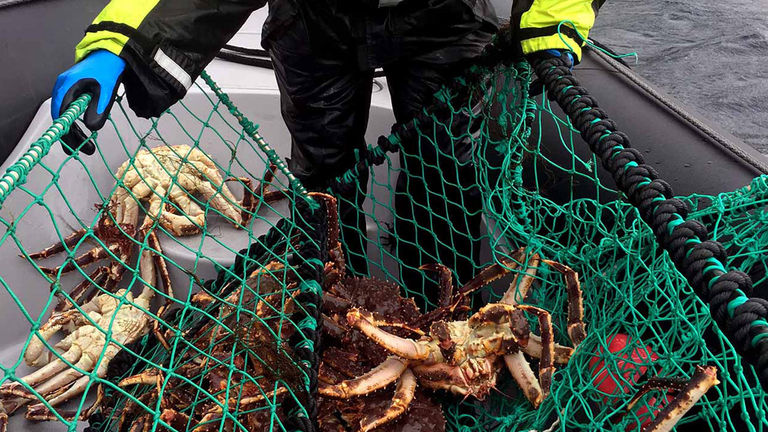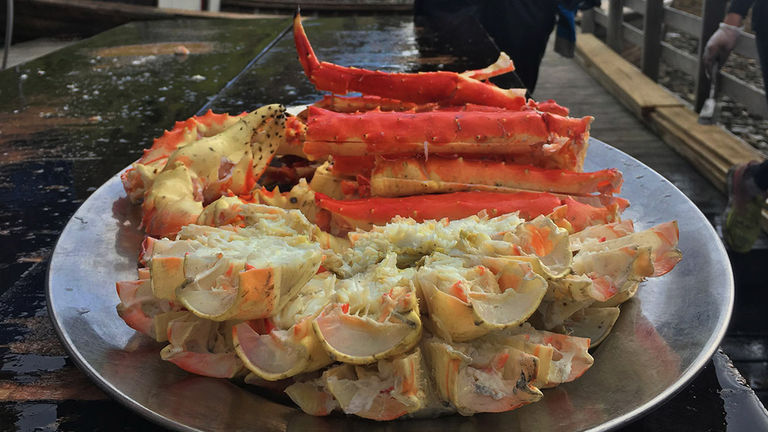Rain and ocean spray pelted my face as the deep-sea rafting boat sped through the choppy waters of Sarnesfjorden. The coast of Honningsvag — the northernmost city in Norway, and one of the country’s smallest — quickly became a dot in the distance as we zoomed toward our goal: catching and eating red king crabs.
The day was windy and overcast, heavy with fast-moving, cotton-puff clouds that tumbled over one another like sprightly spirits. Occasionally, the sun would peer through the mist, casting ethereal beams of light onto the water and the green rolling hills that flanked us to the right.
 Guides from local adventure operator Destinasjon 71 Degrees Nord pull a crab trap from the water.
Guides from local adventure operator Destinasjon 71 Degrees Nord pull a crab trap from the water.
Credit: 2018 Michelle Juergen
I was riding horseback-style on the front seat of the boat, one hand clutching the hood of my thick, black-and-fluorescent-yellow floatation suit against my head, and the other hand white-knuckle-gripping the metal bar in front of me. Our first stop was a marine farm, where Tom and Vilde — our guides from local adventure operator Destinasjon 71 Degrees Nord — would pull a crab trap from the depths.
A small buoy marked the site of the trap, which Tom and Vilde muscled up and over into our small vessel, showcasing the bounty within: a heap of some 20 squirming king crabs. After selecting a couple choice crustaceans, they hurled the trap back into the water, and we continued toward a small pier, where our land guide, Angie, would prepare the crabs for their final resting place (our stomachs).
 The writer with one of the catches of the day.
The writer with one of the catches of the day.
Credit: 2018 Michelle JuergenRed king crabs are the largest of the king crab species; they can grow up to 6 feet between their claws and weigh as much as 22 pounds. Our catches were on the lighter side — about 8 pounds each — but still hefty enough to give our group a sense of how formidable the creatures can be.
While they’re native to the Bering Sea and North Pacific Ocean, red king crabs are now considered an invasive species in Norway; they were introduced artificially in the 1960s by the former Soviet Union to create a new commercial fishery, and they now overrun the waters of the Barents Sea off the northern coasts of Norway and Russia.
Angie regaled us with this history while prepping Calvin and Bobby — the names she gave the crabs — for their fate. She also explained how the crustaceans break down the nets of fishing vessels and consume the food supply of other marine life, therefore decreasing the area’s fish population.
Then, the coup de grace: Angie stabbed a knife into Calvin’s head — the most humane way to kill a crab, as it’s instant, she said — and flipped him upside-down to cut off his legs.
 A guide demonstrates how to kill a king crab, then cuts it up, boils it, cools it and serves it to clients.
A guide demonstrates how to kill a king crab, then cuts it up, boils it, cools it and serves it to clients.
Credit: 2018 Michelle JuergenWe watched, transfixed, as she did the same to Bobby, then followed Angie off the pier and into a tent styled after those that the indigenous Sami people of Arctic Europe once used. Inside the tent, she boiled the crab legs in a large cast-iron pot over an open fire. After they had cooled, Angie presented each of us our share of the delicacy on a wooden board with a lemon wedge, a slice of bread and a dollop of mayo — traditional Norwegian style.
And, for the first time all day, our group did some work: We cracked open crab legs with our hands and feasted on one of the freshest meals we’d ever had.
Note: The 3.5-hour King Crab Safari excursion can be booked through Destinasjon 71 Degrees Nord or through Viking when sailing the 15-day Into the Midnight Sun itinerary onboard Viking Sky.
The Details
Destinasjon 71 Degrees Nord
en.71-nord.no
Viking
www.viking.com